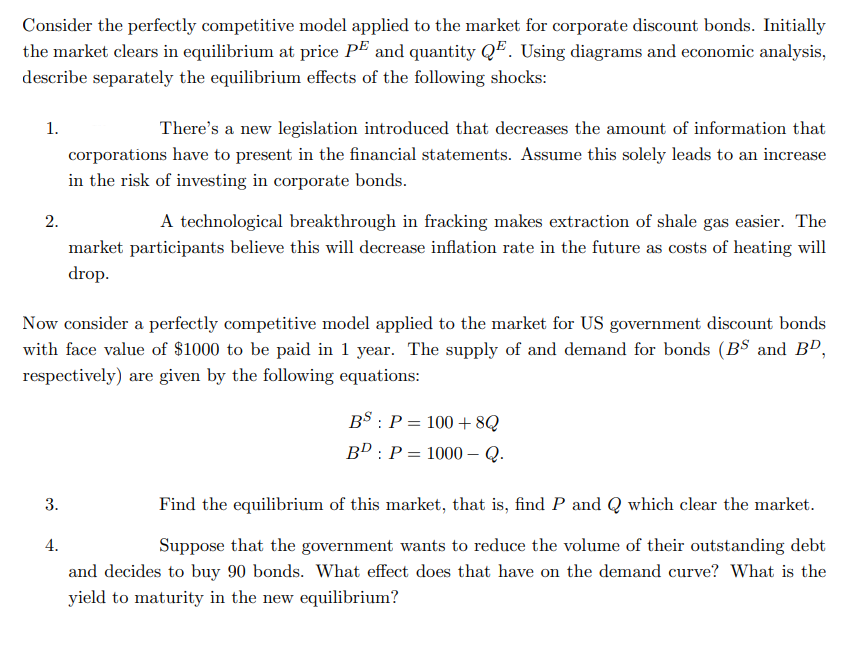Consider the perfectly competitive model applied to the market for corporate discount bonds. Initially the market clears in equilibrium at price PE and quantity QE. Using diagrams and economic analysis, describe separately the equilibrium effects of the following shocks: There's a new legislation introduced that decreases the amount of information that 1. corporations have to present in the financial statements. Assume this solely leads to an increase in the risk of investing in corporate bonds. 2. A technological breakthrough in fracking makes extraction of shale gas easier. The market participants believe this will decrease inflation rate in the future as costs of heating will drop. Now consider a perfectly competitive model applied to the market for US government discount bonds
Consider the perfectly competitive model applied to the market for corporate discount bonds. Initially the market clears in equilibrium at price PE and quantity QE. Using diagrams and economic analysis, describe separately the equilibrium effects of the following shocks: There's a new legislation introduced that decreases the amount of information that 1. corporations have to present in the financial statements. Assume this solely leads to an increase in the risk of investing in corporate bonds. 2. A technological breakthrough in fracking makes extraction of shale gas easier. The market participants believe this will decrease inflation rate in the future as costs of heating will drop. Now consider a perfectly competitive model applied to the market for US government discount bonds
Managerial Economics: Applications, Strategies and Tactics (MindTap Course List)
14th Edition
ISBN:9781305506381
Author:James R. McGuigan, R. Charles Moyer, Frederick H.deB. Harris
Publisher:James R. McGuigan, R. Charles Moyer, Frederick H.deB. Harris
Chapter5: Business And Economic Forecasting
Section: Chapter Questions
Problem 4E
Related questions
Question

Transcribed Image Text:Consider the perfectly competitive model applied to the market for corporate discount bonds. Initially
the market clears in equilibrium at price PE and quantity QE. Using diagrams and economic analysis,
describe separately the equilibrium effects of the following shocks:
1.
There's a new legislation introduced that decreases the amount of information that
corporations have to present in the financial statements. Assume this solely leads to an increase
in the risk of investing in corporate bonds.
2.
A technological breakthrough in fracking makes extraction of shale gas easier. The
market participants believe this will decrease inflation rate in the future as costs of heating will
drop.
Now consider a perfectly competitive model applied to the market for US government discount bonds
with face value of $1000 to be paid in 1 year. The supply of and demand for bonds (B$ and BD,
respectively) are given by the following equations:
BS : P = 100 +8Q
Bº : P
1000 – Q.
3.
Find the equilibrium of this market, that is, find P and Q which clear the market.
4.
Suppose that the government wants to reduce the volume of their outstanding debt
and decides to buy 90 bonds. What effect does that have on the demand curve? What is the
yield to maturity in the new equilibrium?
Expert Solution
This question has been solved!
Explore an expertly crafted, step-by-step solution for a thorough understanding of key concepts.
Step by step
Solved in 2 steps

Knowledge Booster
Learn more about
Need a deep-dive on the concept behind this application? Look no further. Learn more about this topic, economics and related others by exploring similar questions and additional content below.Recommended textbooks for you

Managerial Economics: Applications, Strategies an…
Economics
ISBN:
9781305506381
Author:
James R. McGuigan, R. Charles Moyer, Frederick H.deB. Harris
Publisher:
Cengage Learning


Managerial Economics: Applications, Strategies an…
Economics
ISBN:
9781305506381
Author:
James R. McGuigan, R. Charles Moyer, Frederick H.deB. Harris
Publisher:
Cengage Learning
